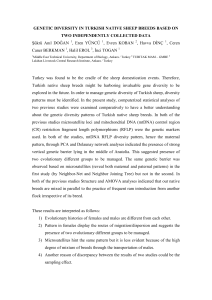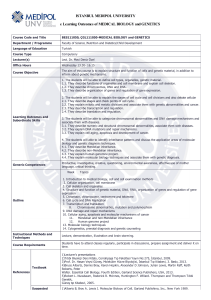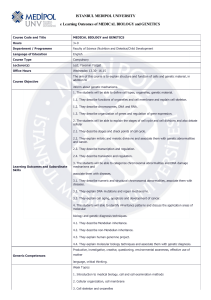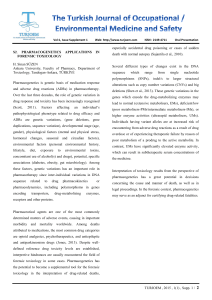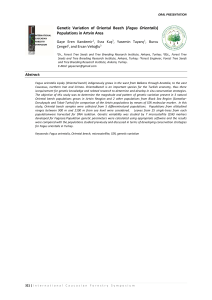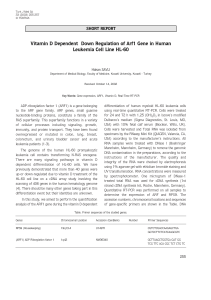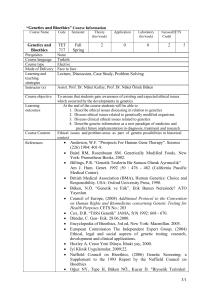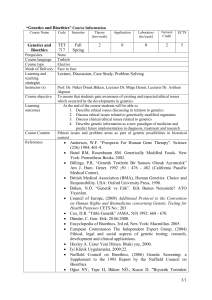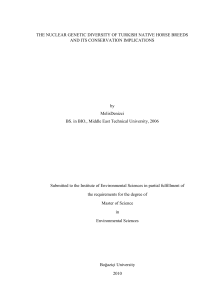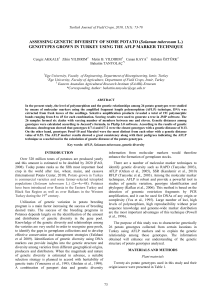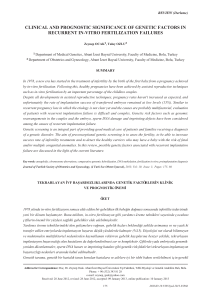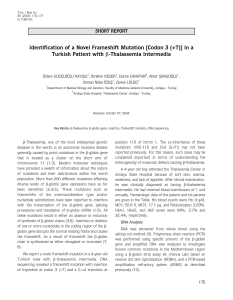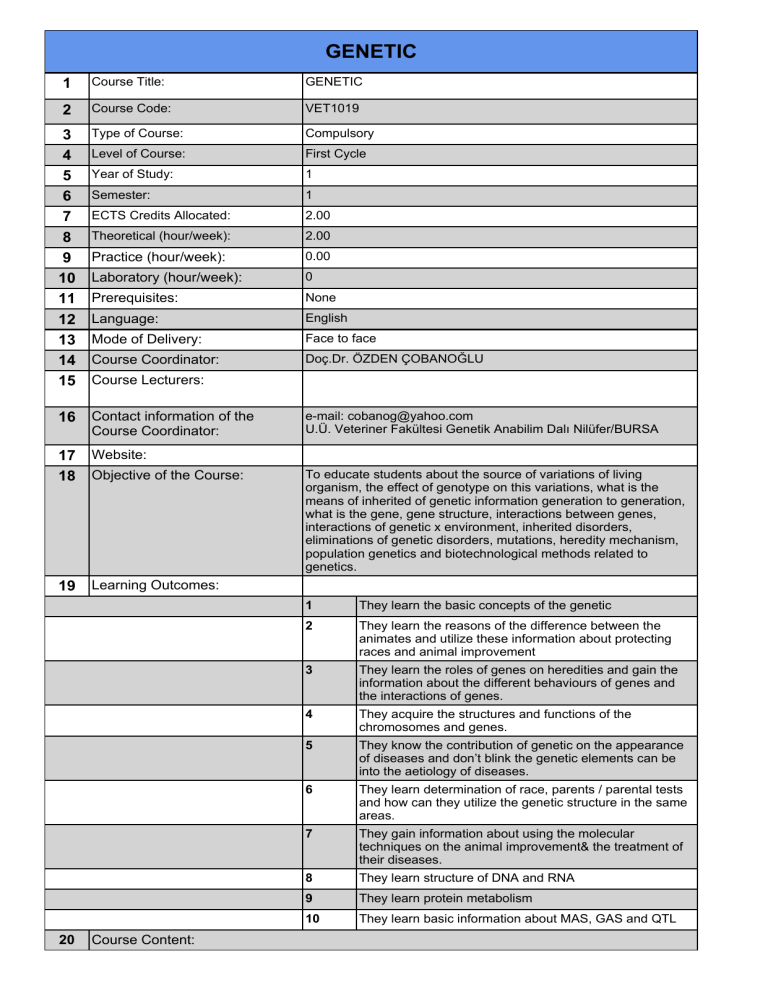
GENETIC
1
Course Title:
GENETIC
2
Course Code:
VET1019
3
4
5
6
7
8
9
10
11
12
13
14
15
Type of Course:
Compulsory
Level of Course:
First Cycle
Year of Study:
1
Semester:
1
ECTS Credits Allocated:
2.00
Theoretical (hour/week):
2.00
Practice (hour/week):
0.00
Laboratory (hour/week):
0
Prerequisites:
None
Language:
English
Mode of Delivery:
Face to face
Course Coordinator:
'Ro'Ug='(1d2%$12ö/8
16
Contact information of the
Course Coordinator:
17
18
Website:
19
Learning Outcomes:
20
Course Lecturers:
Objective of the Course:
Course Content:
e-mail: cobanog@yahoo.com
8h9HWHULQHU)DNOWHVL*HQHWLN$QDELOLP'DOÕ1LOIHU%856$
To educate students about the source of variations of living
organism, the effect of genotype on this variations, what is the
means of inherited of genetic information generation to generation,
what is the gene, gene structure, interactions between genes,
interactions of genetic x environment, inherited disorders,
eliminations of genetic disorders, mutations, heredity mechanism,
population genetics and biotechnological methods related to
genetics.
1
They learn the basic concepts of the genetic
2
They learn the reasons of the difference between the
animates and utilize these information about protecting
races and animal improvement
3
They learn the roles of genes on heredities and gain the
information about the different behaviours of genes and
the interactions of genes.
4
They acquire the structures and functions of the
chromosomes and genes.
5
They know the contribution of genetic on the appearance
of diseases and don’t blink the genetic elements can be
into the aetiology of diseases.
6
They learn determination of race, parents / parental tests
and how can they utilize the genetic structure in the same
areas.
7
They gain information about using the molecular
techniques on the animal improvement& the treatment of
their diseases.
8
They learn structure of DNA and RNA
9
They learn protein metabolism
10
They learn basic information about MAS, GAS and QTL
Course Content:
Week Theoretical
1
Introduction of genetic, character, phenotype,
genotype, environment, environment x
genotype introduction, variations.
2
Kinds of gene and its heredity. (dominant and
recessive heredity, intermediary heredity),
freedom of genes and gametes.
3
Testing combinations. (mono hybridisms, bi
hybridisms, tri hybridisms, poly hybridisms),
Formulas which can be helpful for
combinations.
4
Cells as genetic (cell morphology, cytoplasm,
core, chromatin, Barr substances, DNA, RNA,
proteins, DNA synthesis, DNA regeneration,
RNA synthesis).
5
Chromosomes (Chromosome morphology,
Chromosome types, cerotype, thin structure
of chromosomes, huge Chromosomes).
6
Genes and genetic code (structural genes,
operator genes, regulator genes, the role of
cytoplasm on heredity, protein synthesis on
cell).
7
Division of cell as genetic and the importance
of genetic division, crossing over.
8
Gene relations (epistasis genes , figuring the
both couple of genes on the creation of one
character, pleotropic genes, polymeric
genes).
9
Lethal genes, struggle methods with lethal
genes, heredity depends on sexualities.
10
Immunogenetic (blood groups of
domesticated animals, using techniques for
the studying of blood groups, parental tests,
relations of blood groups with efficiency).
11
Recombination (conjugation, transduction,
transformation).
12
Mutations, (deficiency, deletion, inversion,
duplication, translocation, aneuploidy,
monoploidy, polyploidy, gene mutations).
13
Changes of chromosome numbers.
14
Molecular genetic.
21
Textbooks, References and/or Other
Materials:
22
Assesment
Practice
1*HQHWLN'HUV1RWODUÕ$OWÕQHO$'D÷OÕR÷OX6
øVWDQEXO1993.
20HGLNDO*HQHWLNøONHOHUùD\OÕ%67UNL\H.OLQLNOHUL
<D\ÕQHYL1995.
3. Genetics of Livestock Improvement, Lasley, J. F.,
Prentice-Hall
Inc., Englewood Cliffs, New Jersey, 1998.
4. Genetics and analysis of Quantitative Traits. Lynch,
M., Walsh,
B. Sinauer Associates Inc., Sunderland,
Massachusetts, 1997.
5*HQHWLN(UHQVD\ÕQ&1REHO<D\ÕQ'D÷ÕWÕP$QNDUD
2000.
69HWHULQHU*HQHWLN2GDEDúÕR÷OX)2005.
7. Genetics A Conceptual Approach Second Edition,
Pierce B. A., 2006
TERM LEARNING ACTIVITIES
NUMBE WEIGHT
R
1
Midterm Exam
1
Quiz
0
Home work-project
1
Final Exam
3
Total
Contribution of Term (Year) Learning
Activities to Success Grade
Contribution of Final Exam to Success
Grade
Total
23
40.00
10.00
0.00
50.00
100.00
50.00
50.00
100.00
ECTS / WORK LOAD TABLE
Activites
Number
Duration (hour) Total Work
Load (hour)
Theoretical
14
2.00
28.00
Practicals/Labs
0
0.00
0.00
Self study and preperation
10
1.00
10.00
Homeworks
Projects
Field Studies
Midterm exams
Others
Final Exams
Total Work Load
Total work load/ 30 hr
ECTS Credit of the Course
0
0.00
0.00
0
0.00
0.00
0
0.00
0.00
1
10.00
10.00
0
0.00
0.00
1
12.00
12.00
25
60.00
2.00
2.00
CONTRIBUTION OF LEARNING OUTCOMES TO PROGRAMME
QUALIFICATIONS
PQ1 PQ2 PQ3 PQ4 PQ5 PQ6 PQ7 PQ8 PQ9 PQ1 PQ11 PQ12 PQ1 PQ14 PQ15 PQ16
0
3
ÖK1
5
3
1
1
5
5
3
2
3
2
2
4
0
0
0
0
ÖK2
5
3
1
3
5
5
2
2
2
2
4
5
0
0
0
0
ÖK3
5
3
1
2
5
5
2
3
4
1
4
5
0
0
0
0
ÖK4
5
3
1
2
5
5
2
3
4
1
4
5
0
0
0
0
ÖK5
5
3
1
1
5
5
3
2
3
2
2
4
0
0
0
0
ÖK6
5
3
1
3
5
5
2
2
2
2
4
5
0
0
0
0
ÖK7
5
3
1
2
5
5
2
3
4
1
4
5
0
0
0
0
ÖK8
5
3
1
2
5
5
2
3
4
1
4
5
0
0
0
0
ÖK9
5
3
1
2
5
5
2
3
4
1
4
5
0
0
0
0
ÖK10
5
3
1
2
5
5
2
3
4
1
4
5
0
0
0
0
LO: Learning Objectives
Contrib
ution
Level:
1 very low
2 low
PQ: Program Qualifications
3 Medium
4 High
5 Very High

